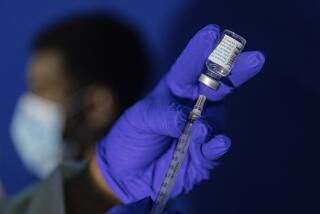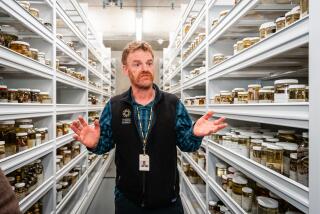Profile : Colombian Tackles Malaria and Skeptics : Maverick scientist has had to convince critics worldwide that his synthetic vaccine can deter the deadly disease.
- Share via
BOGOTA, Colombia — In a stately 19th-Century building of marble and gold trim, young Colombian scientists are splitting molecules, deciphering DNA and creating chemically synthesized proteins in a battle against one of the world’s most deadly diseases: malaria.
The wizard directing this project on the grounds of the San Juan de Dios Hospital is Dr. Manuel Elkin Patarroyo. The 46-year-old biochemist is developing a synthetic vaccine that for the first time could successfully slow the spread of the stubborn tropical disease, which kills about 3 million people each year.
In tests on more than 20,000 people in Africa, Thailand and Latin America, the vaccine is showing promise and, after considerable skepticism, it is finally receiving international attention and some acceptance.
“These are no longer dreams,” Patarroyo said. “These are facts.”
Patarroyo is director of the Colombian National University’s Immunology Institute, housed on the edge of the hospital compound. He is refurbishing several buildings to create a complex of laboratories where he hopes to produce the vaccine in bulk.
A man of seemingly endless energy--and confidence--Patarroyo has become a celebrity in his homeland, a violent country known more for drug traffickers and car bombs.
As the vaccine gradually passes scientific muster, Patarroyo is regularly solicited for international conferences and is racking up awards the world over. For Patarroyo, there is a touch of national pride: This is the first vaccine created in a developing country without commercial funding, according to the United Nations’ Research and Training in Tropical Diseases program.
Malaria is a treacherous, mosquito-borne disease that causes fevers and severe headaches and can recur numerous times. Tens of millions of people come down with it every year.
If final testing, under way now, proves successful, the vaccine could become available to the public in a few years at an incredibly cheap price: Patarroyo estimates he can give a child the three-dose regimen for less than 50 cents. Because malaria is most prevalent and most deadly in the impoverished Third World, the implications are far-reaching.
Perhaps most remarkable, Patarroyo donated the vaccine patent to the World Health Organization for $1, saying it was “Colombia’s gift to the world.” Consequently, he will not profit from its production.
Patarroyo’s road to scientific acceptance has been a long one.
Reared in a family of doctors and trained in chemistry at Yale and Rockefeller universities, Patarroyo says he always dreamed of serving his country in science or medicine. He saw his opening during a visit to Colombia’s malaria-infested Pacific Coast, and from there he began studying the composition of the malaria parasite, Plasmodium falciparum.
Most conventional vaccines are produced from the germ that causes the disease. A weakened form of the germ is introduced into the body, triggering antibodies that fight the disease.
Patarroyo identified proteins carried by the malaria parasite. Then his real breakthrough came when he decided he could chemically synthesize those proteins en masse and produce the vaccine by attaching the proteins to a carrier molecule.
“Making a chemical vaccine has been considered a breakthrough,” he said. “You don’t have to wait for it to be born in nature, biologically. You make it chemically.”
But the unorthodox Patarroyo was seen in the scientific community as a maverick, and worse. At first, his work was dismissed.
His field tests were seen as sloppy, he was producing the vaccine in his own laboratory and not under international standards, and he did not submit his data to the scrutiny of fellow investigators. His enthusiastic, showboat style turned off a lot of scientists.
He came under attack for moving too quickly from experimenting with Amazonian monkeys to injecting humans--Colombian soldiers. When the Centers for Disease Control in Atlanta sought to reproduce his work in 1990, they did not get the same results, compounding the doubts.
Finally, Patarroyo made the push for international acceptance. He began to bring his work in line with guidelines his colleagues could accept. He had the vaccine, which is named SPf66, produced at a San Diego laboratory and then he conducted internationally supervised tests on 1,548 Pacific Coast Colombians.
In March, 1993, the international medical journal Lancet published the results. The trials showed a nearly 40% reduction in the incidence of malaria among vaccinated subjects and a 77% reduction in children younger than 4, a particularly vulnerable group. In some parts of the world, up to 25% of children die from malaria. A 67% reduction was reported in adults over 45.
Even though the 40% rate was lower than what Patarroyo had earlier claimed, reaction was positive. The Pan-American Health Organization called the vaccine a “potential, fantastic lifesaver.”
“I think he’s got a good vaccine,” Dr. Trenton Ruebush, chief of the malaria section of the CDC’s parasitic disease division, said in a telephone interview. “I don’t think he has a great vaccine. It’s certainly not as good as he wants to think. But he’s gone a lot further than anyone else. He’s clearly far ahead of the other groups” developing vaccines.
The once-skeptical WHO was impressed enough to contract with Patarroyo for more tests. Most of the research had been financed by the Colombian government.
Patarroyo was determined to continue his efforts to perfect the vaccine. A central question remained about how effective the vaccine would be in areas like sub-Saharan Africa where malaria is endemic. Studies on 600 Tanzanian children are seen as a key test, and the United Kingdom’s Medical Research Council, after first rejecting requests, has approved trials in Gambia.
No one is suggesting that the vaccine will end malaria. The parasite is known for its adaptability and can evolve to become more resistant. But even if only half the likely victims of the disease can be protected, hundreds of thousands of lives could be saved annually.
Patarroyo, a slightly built, gregarious man, relishes the attention his work is receiving. He has just won the Prince of Asturias award from Spain and the Medal of Edinburgh, and in October he will be presented with the Robert Koch Prize in Bonn, citing his “pioneering work.”
To visitors, he distributes a page from Parasitology Today with a timeline of “Milestones in Parasitology.” It begins with Hippocrates and Aristotle in the 4th and 5th Centuries B.C. discovering worms and the seasonal nature of disease, and ends with last year’s report of Patarroyo’s first large-scale successful vaccine trials.
As for those who doubted, and continue to doubt, Patarroyo says he does not begrudge them.
“It is difficult to understand an achievement like this in the middle of nowhere and, scientifically, Colombia is the middle of nowhere,” he said. “I don’t blame them.
“The worst thing they said was that I was making up lies. They said I was a charlatan. But I understand them and I have no negative feelings. Colombia has no history of scientific development. . . .”
Patarroyo’s institute has the busy feel of a bus station, his 60-plus white-coated researchers scurrying about with vials of cloned protein segments.
Patarroyo is hiring 40 more researchers and beginning to turn the institute’s attention to tuberculosis and other infectious diseases that he is convinced can be fought with chemically synthesized vaccines.
“The concept is that every single vaccine can be made chemically, and with each batch you can vaccinate thousands and thousands of people,” he said. “That is the beauty of it.”
Biography
Name: Manuel Elkin Patarroyo
Title: Director of the Colombian National University’s Immunology Institute.
Age: 46
Personal: Studied at the National University of Colombia and Yale and Rockefeller universities. Married to Maria Cristina de Patarroyo, a pediatrician. Has two sons and a daughter. The eldest son, Manuel Alfonso, is a molecular biologist and works at Patarroyo’s Immunology Institute.
Quote: “I always wanted to give a malaria vaccine to mankind. My idols are Aristotle, Darwin, Pasteur. . . . It’s nice to beat the idols and solve a problem they were not able to.
Stalking a Killer
Malaria strikes tens of millions of people each year. The mosquito-borne disease is most prevalent and most deadly in the Third World, particularly Africa.
Reported malaria cases, 1981-91 (in thousands)**:
Africa***
1981: 6,754
1982: 6,042
1983: 2,726
1984: 4,523
1985: 11,634
1986: 17,442
1987: 19,463
1988: 21,597
1989: 13,853
1990: ...
1991: ...
*
Americas
1981: 638
1982: 718
1983: 831
1984: 932
1985: 911
1986: 951
1987: 1,018
1988: 1,120
1989: 1,114
1990: 1,057
1991: 1,231
*
Eastern Mediter.
1981: 207
1982: 308
1983: 305
1984: 335
1985: 391
1986: 611
1987: 566
1988: 602
1989: 532
1990: 584
1991: 535
*
Europe
1981: 60
1982: 66
1983: 73
1984: 62
1985: 57
1986: 47
1987: 28
1988: 25
1989: 21
1990: 14
1991: 16
*
Southeast Asia
1981: 3,566
1982: 2,964
1983: 2,731
1984: 3,004
1985: 2,503
1986: 2,689
1987: 2,823
1988: 2,789
1989: 2,957
1990: 2,724
1991: 3,027
*
Western Pacific
1981: 3,464
1982: 2,487
1983: 1,839
1984: 1,410
1985: 1,178
1986: 1,012
1987: 893
1988: 774
1989: 829
1990: 790
1991: 817
*
**The information provided is not complete in some instances.
***Figures for Africa are estimates because most countries do not have formal reporting systems.
Source: World Health Organization
More to Read
Sign up for Essential California
The most important California stories and recommendations in your inbox every morning.
You may occasionally receive promotional content from the Los Angeles Times.














